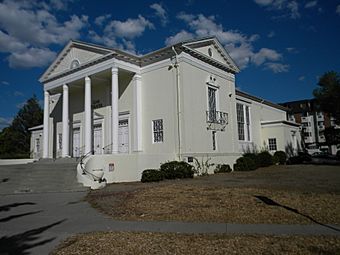First Church of Christ, Scientist (Reno, Nevada) facts for kids
Quick facts for kids |
|
|
First Church of Christ, Scientist
|
|
 |
|
| Location | 501 Riverside Dr., Reno, Nevada |
|---|---|
| Area | 0.6 acres (0.24 ha) |
| Built | 1939 |
| Architect | Paul Revere Williams; builder: Boudwin, Walker |
| Architectural style | Classical Revival |
| NRHP reference No. | 99000939 |
| Added to NRHP | August 20, 1999 |
The Lear Theater in Reno, Nevada, is a special building with a rich history. It was built in 1939 as the First Church of Christ, Scientist. This beautiful building stands at 501 Riverside Drive, right next to the Truckee River.
Contents
A Historic Building in Reno
This building was originally a Christian Science church. It was designed in the Classical Revival style, which means it looks like ancient Greek or Roman buildings. A wealthy local Christian Scientist named Anna Frandsen Loomis paid for the entire building. She spent about $120,000, which was a lot of money back then!
The Architect Behind the Design
Anna Frandsen Loomis chose a very famous architect named Paul Revere Williams to design the church. He was from Los Angeles. Paul Revere Williams was a groundbreaking architect. He was the first African-American person to become a member of the AIA. This was a huge achievement in his time.
From Church to Theater
For many years, the building served as a church. However, in 1998, the church congregation decided to sell the building. They used the money from the sale to build a new church in a different location.
A kind person named Moya Lear, who loved theater, donated $1.1 million. This money helped the Reno-Sparks Theater Community Coalition buy the old church building. They then renamed it the Lear Theater in her honor. Today, it is a place for performances and community events.
A Place in History
The Lear Theater is recognized as an important historical site. On December 28, 1982, it was added to the Nevada State Register of Historic Places. Later, on August 20, 1999, it was also added to the National Register of Historic Places. This means the building is protected because of its historical and architectural importance.



